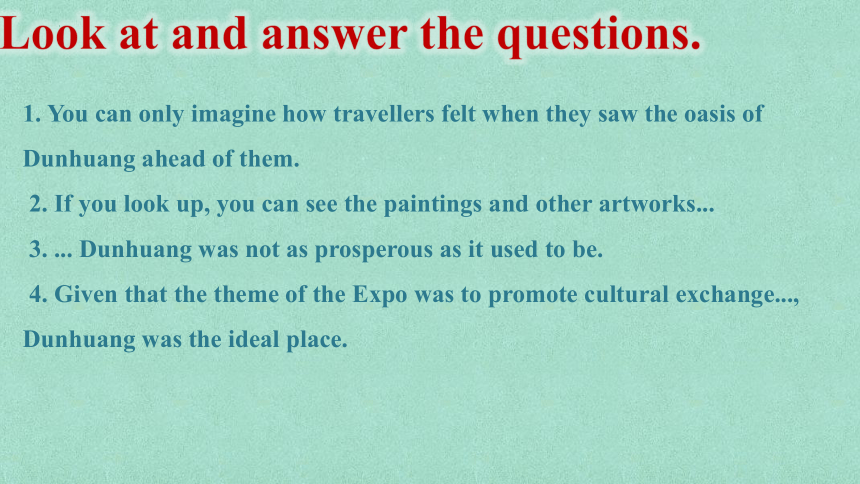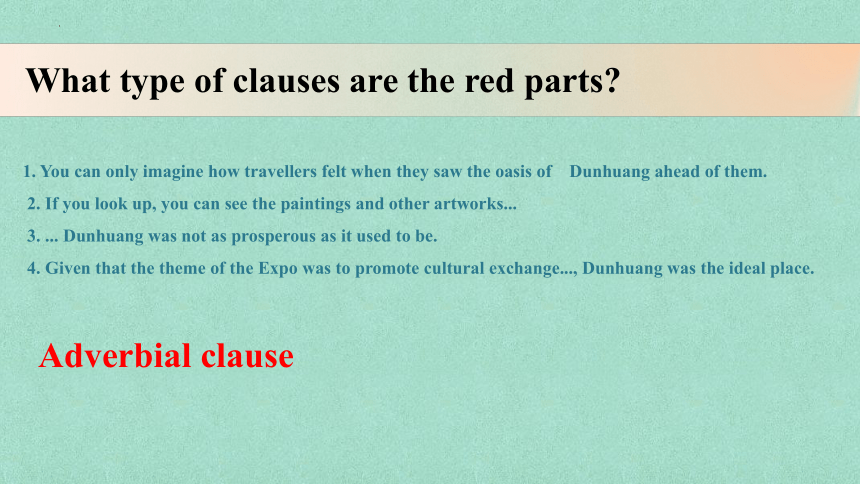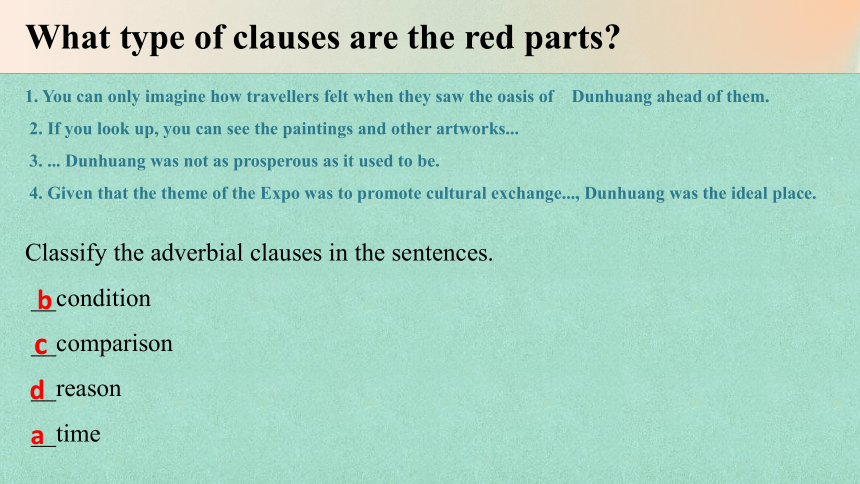外研版(2019)选择性必修 第四册Unit 3 The world meets China Using language课件-(32张ppt)
文档属性
| 名称 | 外研版(2019)选择性必修 第四册Unit 3 The world meets China Using language课件-(32张ppt) |

|
|
| 格式 | pptx | ||
| 文件大小 | 5.3MB | ||
| 资源类型 | 教案 | ||
| 版本资源 | 外研版(2019) | ||
| 科目 | 英语 | ||
| 更新时间 | 2023-04-14 21:53:25 | ||
图片预览












文档简介
(共32张PPT)
UNIT 3
The world meets China
---
Using language
1. Students could learn some words and phrases.
2. Students could get the main usage of this grammar.
3. Students could write sentences by using this grammar.
Learning Aims:
复习:状语从句
Review: adverbial clauses
What is your understanding of this title?
Share with others
Brainstorming:Before learning this grammar, what ideas come to your mind
1. attributive clause
2. object clause
3. ...
Look at and answer the questions.
1. You can only imagine how travellers felt when they saw the oasis of Dunhuang ahead of them.
2. If you look up, you can see the paintings and other artworks...
3. ... Dunhuang was not as prosperous as it used to be.
4. Given that the theme of the Expo was to promote cultural exchange..., Dunhuang was the ideal place.
Adverbial clause
What type of clauses are the red parts
1. You can only imagine how travellers felt when they saw the oasis of Dunhuang ahead of them.
2. If you look up, you can see the paintings and other artworks...
3. ... Dunhuang was not as prosperous as it used to be.
4. Given that the theme of the Expo was to promote cultural exchange..., Dunhuang was the ideal place.
What type of clauses are the red parts
1. You can only imagine how travellers felt when they saw the oasis of Dunhuang ahead of them.
2. If you look up, you can see the paintings and other artworks...
3. ... Dunhuang was not as prosperous as it used to be.
4. Given that the theme of the Expo was to promote cultural exchange..., Dunhuang was the ideal place.
Classify the adverbial clauses in the sentences.
__condition
__comparison
__reason
__time
b
c
d
a
China’s High Speed Rail (HSR)
In 2008, China’s HSR service started.
In 2015, a major breakthrough
in technology was made, using
independent R&D.
Now, China cooperates with dozens
of countries in the world to develop
HSR services overseas.
Describe another Chinese innovation that has had
a great impact both at home and abroad.
shared bikes
Ali pay
online shopping
high speed train
状语从句Adverbial Clause
状语从句 (Adverbial Clause) 是指句子用作状语时,起副词作用的句子。状语从句可以修饰谓语、非谓语动词、定语、状语或整个句子。
状语从句根据其作用可分为时间、地点、原因、条件、目的、结果、让步、方式和比较等从句。状语从句一般由连词(从属连词)引导,也可以由词组引起。从句位于句首或句中时通常用逗号与主句隔开,位于句尾时可以不用逗号隔开。
一般情况下,时间和条件状语从句的谓语动词一般用“一般现在时”表示“一般将来时”,用“现在完成时”表示“将来完成时”。例如:
I will call you as soon as I arrive in Beijing. 我到北京就将给你打电话。
(这是由as soon as引导的时间状语从句,从句中的谓语动词arrive是一般现在时,表示一般将来时,绝不可用will arrive)
As soon as I have finished this work, I will have gone home.我一完成这项工作,就会回家。
(从句中的谓语动词用现在完成时have finished,表示将来完成时,绝不可用will have finished)
If he comes back, please let me know.如果他回来了,请通知我。
(从句中的谓语动词用comes back,表示一般将来时,绝不可用will come back)
从句通常结构:主 do sth.\do sb.(条件)+ V.\结果
一、时间状语从句
常用引导词:when(在…时), as(当…时), while(在…期间), before(在…之前), after(在...之后), since(自从...以来) , not...until(直到…才)until/till(直到…时)等
特殊引导词:the minute, the moment, the second, every time, the day,the instant( 瞬间,顷刻), immediately , directly(不久,立即), no sooner … than(一...就...), hardly …when(刚一...就...) , scarcely … when(刚...就.../一...就...),as soon as(一…就…)。
当用no sooner … than,hardly …when,scarcely … when作为引导词的时候,从句要部分倒装。
I didn’t realize how special my mother was until I became an adult.
While John was watching TV, his wife was cooking.
二、地点状语从句
常用引导词:where
特殊引导词:wherever, anywhere, everywhere
Generally, air will be heavily polluted where there are factories.
地点状语从句一般由连接副词where, wherever等引导,已经形成了固定的句型,例如:
Where there is no rain, farming is difficult or impossible.
They were good persons. Where they went, there they were warmly welcomed.
You should have put the book where you found it.
Where the Communist Party of China goes, there the people are liberated.
三、原因状语从句
常用引导词:because, since, as,
特殊引导词:seeing that, now that, in that, considering that, given that.
My friends dislike me because I’m handsome and successful.
Now that everybody has come, let’s begin our conference.
The higher income tax is harmful in that it may discourage people from trying to earn more.
四、目的状语从句
常用引导词:so that, in order that
特殊引导词:lest, in case, for fear that,in the hope that, for the purpose of , to the end that
The boss asked the secretary to hurry up with the letters so that he could sign them.
The teacher raised his voice on purpose that the students in the back could hear more clearly.
五、结果状语从句
常用引导词:so … that, such … that, so that...
特殊引导词:such that, to the degree that, to the extent that, to such a degree that,
He got up so early that he caught the first bus.
It’s such a good chance that we must not miss it.
To such a degree was he excited that he couldn’t sleep last night.
This news is exciting, so that he jumped up.
典型例题
1) ___she is young, she knows quite a lot.
A. When B. However C. Although D. Unless
2) as, though 引导的倒装句
as / though引导的让步从句必须表语或状语提前.
Child as /though he was, he knew what was the right thing to do.
答案:C。意为虽然她很年轻,却知道许多。
= Though he was a small child, he knew what was the right thing to do.
Timeline
The second century BC:
Zhang Qian, a diplomat, gave a reliable
account of the lands of Central Asia for the Han court.
The first century AD:
Gan Ying, a military envoy, explored the Persian
Gulf and became the first Chinese to get
information on Europe.
Take notes quickly!
重点词汇
diplomat 外交官 ; 善于交际的人
account of 的帐户 ; 由于 ; 帐内
Central Asia 中亚 ; 中亚细亚
envoy 特使 ; 使者 ; 使节 ; 代表
explored 勘探 ; 勘查 ;
Persian 波斯人 ; 波斯语
Gulf 海湾 ; 波斯湾 ;
The 7th century:
Xuanzang, a Chinese monk, scholar and traveller, translated volumes of scriptures from Sanskrit to Chinese. He also wrote The Great Tang Dynasty Record of the Western Regions, a description of the countries he visited on his travels.
The 15th century:
Zheng He sailed to South-east Asia, South Asia, West Asia, and East Africa. Some of his voyages comprised as many as sixty treasure ships. These voyages led to a legacy of cultural exchange between China and other countries.
Take notes quickly!
重点词汇
Sanskrit 梵语
Tang Dynasty 唐朝;唐室
South Asia 南亚 ; 东南亚 ; 南亚地区
West Asia 西亚 ; 努曼西亚
East Africa 东非 ; 东部非洲 ; 东非地区 ; 东非洲
voyages 航行 ; 航海,
as many as 多达…
cultural exchange 文化交流
The 8th century:
After six attempts, over a period of twelve years,
Chinese monk Jianzhen arrived in Japan, where
he promoted exchange and understanding
between China and Japan.
The 13th century:
Marco Polo travelled from Europe to
Asia. The Travels of Marco Polo served to
bring knowledge of Asia to the West.
Take notes quickly!
重点词汇
attempts 企图 ; 试图 ; 尝试 ;
monk 和尚 ; 僧侣 ; 修道士
century 世纪
promoted 促进 ; 推动 ;
Marco Polo 马可波罗
The Confucius Institute is a non-profit educational organisation run by the Chinese
Ministry of Education, aiming to promote Chinese language and culture abroad and
to encourage cultural exchange. The first institute opened in 2004, and today there are
over 500 institutes around the world. In addition to Chinese language courses, the
institutes also support activities, such as art exhibitions, conferences and film festivals.
Take notes quickly!
重点词汇
Confucius Institute 孔子学院
Ministry of Education 教育部 ;
aim at 力求达到 ; 力争做到
cultural exchange 文化交流
institutes 机构,机构建筑
around the world 全世界
In addition to 除了 ; 另外,加之,
support activities 支持活动 ;
such as 例如
Work in pairs. Discuss what you can do to spread Chinese culture.
your opinions
... ...
stature
writing
Try to think about others
Question
Talk with others.
Write your ideas.
1.
2.
3.
Thank you!
UNIT 3
The world meets China
---
Using language
1. Students could learn some words and phrases.
2. Students could get the main usage of this grammar.
3. Students could write sentences by using this grammar.
Learning Aims:
复习:状语从句
Review: adverbial clauses
What is your understanding of this title?
Share with others
Brainstorming:Before learning this grammar, what ideas come to your mind
1. attributive clause
2. object clause
3. ...
Look at and answer the questions.
1. You can only imagine how travellers felt when they saw the oasis of Dunhuang ahead of them.
2. If you look up, you can see the paintings and other artworks...
3. ... Dunhuang was not as prosperous as it used to be.
4. Given that the theme of the Expo was to promote cultural exchange..., Dunhuang was the ideal place.
Adverbial clause
What type of clauses are the red parts
1. You can only imagine how travellers felt when they saw the oasis of Dunhuang ahead of them.
2. If you look up, you can see the paintings and other artworks...
3. ... Dunhuang was not as prosperous as it used to be.
4. Given that the theme of the Expo was to promote cultural exchange..., Dunhuang was the ideal place.
What type of clauses are the red parts
1. You can only imagine how travellers felt when they saw the oasis of Dunhuang ahead of them.
2. If you look up, you can see the paintings and other artworks...
3. ... Dunhuang was not as prosperous as it used to be.
4. Given that the theme of the Expo was to promote cultural exchange..., Dunhuang was the ideal place.
Classify the adverbial clauses in the sentences.
__condition
__comparison
__reason
__time
b
c
d
a
China’s High Speed Rail (HSR)
In 2008, China’s HSR service started.
In 2015, a major breakthrough
in technology was made, using
independent R&D.
Now, China cooperates with dozens
of countries in the world to develop
HSR services overseas.
Describe another Chinese innovation that has had
a great impact both at home and abroad.
shared bikes
Ali pay
online shopping
high speed train
状语从句Adverbial Clause
状语从句 (Adverbial Clause) 是指句子用作状语时,起副词作用的句子。状语从句可以修饰谓语、非谓语动词、定语、状语或整个句子。
状语从句根据其作用可分为时间、地点、原因、条件、目的、结果、让步、方式和比较等从句。状语从句一般由连词(从属连词)引导,也可以由词组引起。从句位于句首或句中时通常用逗号与主句隔开,位于句尾时可以不用逗号隔开。
一般情况下,时间和条件状语从句的谓语动词一般用“一般现在时”表示“一般将来时”,用“现在完成时”表示“将来完成时”。例如:
I will call you as soon as I arrive in Beijing. 我到北京就将给你打电话。
(这是由as soon as引导的时间状语从句,从句中的谓语动词arrive是一般现在时,表示一般将来时,绝不可用will arrive)
As soon as I have finished this work, I will have gone home.我一完成这项工作,就会回家。
(从句中的谓语动词用现在完成时have finished,表示将来完成时,绝不可用will have finished)
If he comes back, please let me know.如果他回来了,请通知我。
(从句中的谓语动词用comes back,表示一般将来时,绝不可用will come back)
从句通常结构:主 do sth.\do sb.(条件)+ V.\结果
一、时间状语从句
常用引导词:when(在…时), as(当…时), while(在…期间), before(在…之前), after(在...之后), since(自从...以来) , not...until(直到…才)until/till(直到…时)等
特殊引导词:the minute, the moment, the second, every time, the day,the instant( 瞬间,顷刻), immediately , directly(不久,立即), no sooner … than(一...就...), hardly …when(刚一...就...) , scarcely … when(刚...就.../一...就...),as soon as(一…就…)。
当用no sooner … than,hardly …when,scarcely … when作为引导词的时候,从句要部分倒装。
I didn’t realize how special my mother was until I became an adult.
While John was watching TV, his wife was cooking.
二、地点状语从句
常用引导词:where
特殊引导词:wherever, anywhere, everywhere
Generally, air will be heavily polluted where there are factories.
地点状语从句一般由连接副词where, wherever等引导,已经形成了固定的句型,例如:
Where there is no rain, farming is difficult or impossible.
They were good persons. Where they went, there they were warmly welcomed.
You should have put the book where you found it.
Where the Communist Party of China goes, there the people are liberated.
三、原因状语从句
常用引导词:because, since, as,
特殊引导词:seeing that, now that, in that, considering that, given that.
My friends dislike me because I’m handsome and successful.
Now that everybody has come, let’s begin our conference.
The higher income tax is harmful in that it may discourage people from trying to earn more.
四、目的状语从句
常用引导词:so that, in order that
特殊引导词:lest, in case, for fear that,in the hope that, for the purpose of , to the end that
The boss asked the secretary to hurry up with the letters so that he could sign them.
The teacher raised his voice on purpose that the students in the back could hear more clearly.
五、结果状语从句
常用引导词:so … that, such … that, so that...
特殊引导词:such that, to the degree that, to the extent that, to such a degree that,
He got up so early that he caught the first bus.
It’s such a good chance that we must not miss it.
To such a degree was he excited that he couldn’t sleep last night.
This news is exciting, so that he jumped up.
典型例题
1) ___she is young, she knows quite a lot.
A. When B. However C. Although D. Unless
2) as, though 引导的倒装句
as / though引导的让步从句必须表语或状语提前.
Child as /though he was, he knew what was the right thing to do.
答案:C。意为虽然她很年轻,却知道许多。
= Though he was a small child, he knew what was the right thing to do.
Timeline
The second century BC:
Zhang Qian, a diplomat, gave a reliable
account of the lands of Central Asia for the Han court.
The first century AD:
Gan Ying, a military envoy, explored the Persian
Gulf and became the first Chinese to get
information on Europe.
Take notes quickly!
重点词汇
diplomat 外交官 ; 善于交际的人
account of 的帐户 ; 由于 ; 帐内
Central Asia 中亚 ; 中亚细亚
envoy 特使 ; 使者 ; 使节 ; 代表
explored 勘探 ; 勘查 ;
Persian 波斯人 ; 波斯语
Gulf 海湾 ; 波斯湾 ;
The 7th century:
Xuanzang, a Chinese monk, scholar and traveller, translated volumes of scriptures from Sanskrit to Chinese. He also wrote The Great Tang Dynasty Record of the Western Regions, a description of the countries he visited on his travels.
The 15th century:
Zheng He sailed to South-east Asia, South Asia, West Asia, and East Africa. Some of his voyages comprised as many as sixty treasure ships. These voyages led to a legacy of cultural exchange between China and other countries.
Take notes quickly!
重点词汇
Sanskrit 梵语
Tang Dynasty 唐朝;唐室
South Asia 南亚 ; 东南亚 ; 南亚地区
West Asia 西亚 ; 努曼西亚
East Africa 东非 ; 东部非洲 ; 东非地区 ; 东非洲
voyages 航行 ; 航海,
as many as 多达…
cultural exchange 文化交流
The 8th century:
After six attempts, over a period of twelve years,
Chinese monk Jianzhen arrived in Japan, where
he promoted exchange and understanding
between China and Japan.
The 13th century:
Marco Polo travelled from Europe to
Asia. The Travels of Marco Polo served to
bring knowledge of Asia to the West.
Take notes quickly!
重点词汇
attempts 企图 ; 试图 ; 尝试 ;
monk 和尚 ; 僧侣 ; 修道士
century 世纪
promoted 促进 ; 推动 ;
Marco Polo 马可波罗
The Confucius Institute is a non-profit educational organisation run by the Chinese
Ministry of Education, aiming to promote Chinese language and culture abroad and
to encourage cultural exchange. The first institute opened in 2004, and today there are
over 500 institutes around the world. In addition to Chinese language courses, the
institutes also support activities, such as art exhibitions, conferences and film festivals.
Take notes quickly!
重点词汇
Confucius Institute 孔子学院
Ministry of Education 教育部 ;
aim at 力求达到 ; 力争做到
cultural exchange 文化交流
institutes 机构,机构建筑
around the world 全世界
In addition to 除了 ; 另外,加之,
support activities 支持活动 ;
such as 例如
Work in pairs. Discuss what you can do to spread Chinese culture.
your opinions
... ...
stature
writing
Try to think about others
Question
Talk with others.
Write your ideas.
1.
2.
3.
Thank you!
